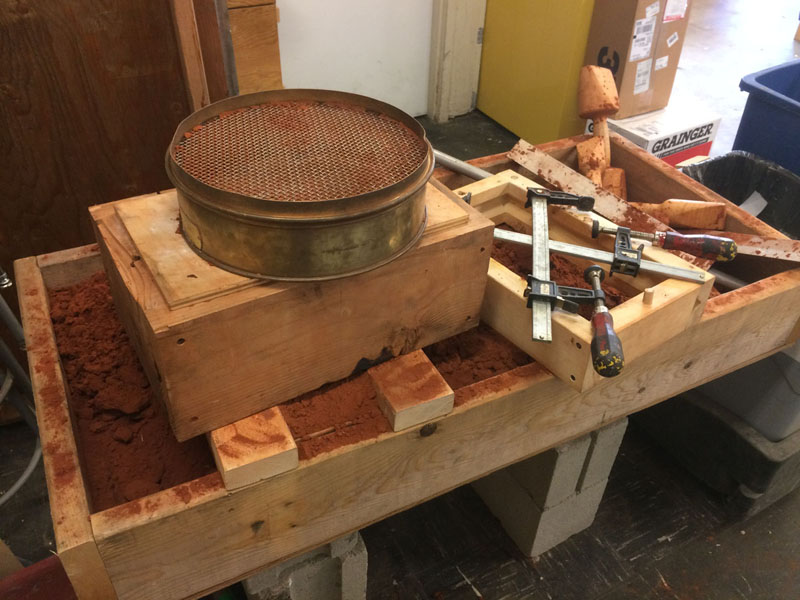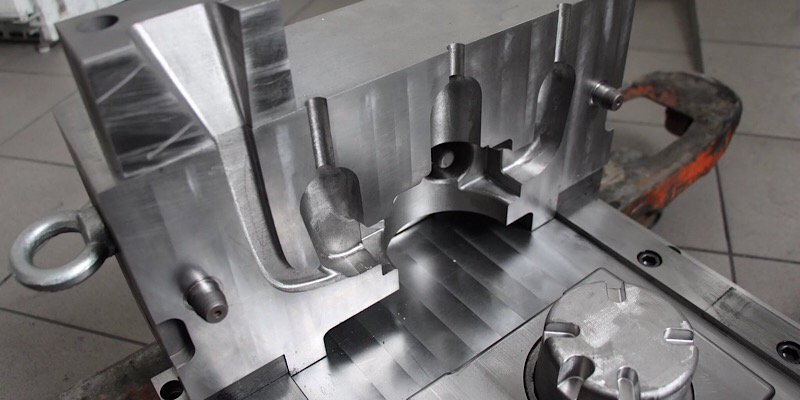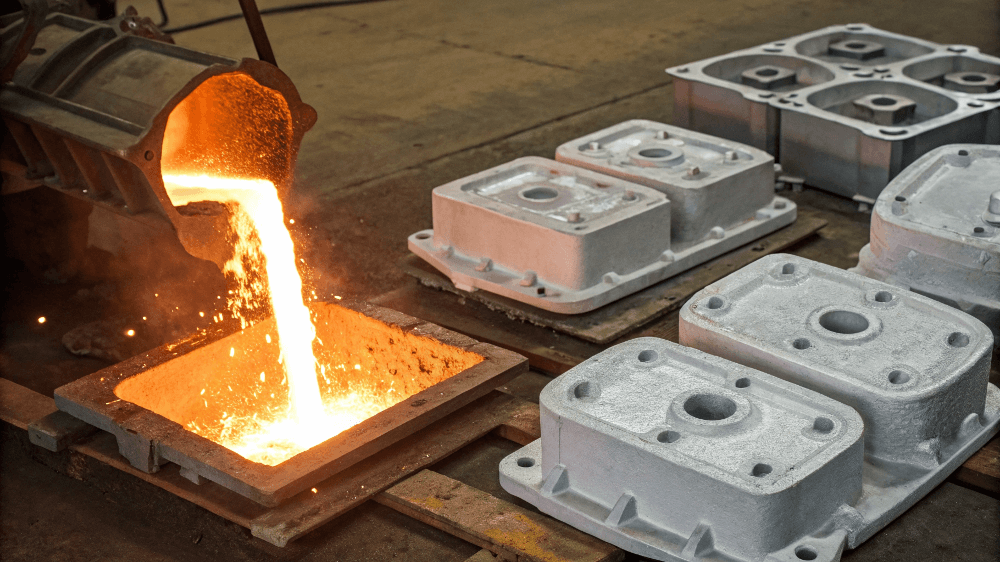Reviewing Aluminum Foundry Wisconsin and its role in custom casting
A Comprehensive Overview to the Strategies Used in Aluminum Foundry Workflow
Aluminum Foundry procedures employ different casting techniques, each with distinctive processes and applications. Comprehending these methods is important for enhancing manufacturing and achieving preferred product buildings. From sand casting to pass away casting, the choices offered can substantially influence efficiency and expense. As innovation advancements, so too do these methods, prompting a more detailed assessment of their restrictions and advantages. The implications of these advancements require more expedition.
Introduction of Aluminum Spreading Techniques
Aluminum casting methods incorporate a variety of methods used to shape liquified Aluminum into wanted types. These methods are essential in the manufacturing and engineering fields, providing convenience and effectiveness. Major techniques include pass away casting, which uses high-pressure to infuse Aluminum right into molds for precision parts, and gravity casting, where liquified Aluminum is put into mold and mildews intoxicated of gravity, permitting for larger, much less complex forms. Investment spreading, an additional technique, entails creating a wax pattern coated in ceramic, giving high dimensional accuracy for complex layouts. Additionally, irreversible mold and mildew casting makes use of reusable molds, improving manufacturing effectiveness and lowering waste. Each technique deals with details applications, balancing elements such as expense, manufacturing volume, and material residential properties. As industries develop, innovations in these casting methods continue to boost the quality and performance of Aluminum components, positioning them as necessary procedures within contemporary production.
Sand Spreading: Process and Applications
Sand casting is a commonly made use of approach in the Foundry industry, known for its simplicity and flexibility. Aluminum Foundry. This procedure entails creating a mold from a mixture of sand and a bonding agent, usually clay. The mold and mildew is created around a pattern, which is a reproduction of the wanted last item. As soon as the mold and mildew is prepared, molten Aluminum is put right into the cavity, allowing it to solidify right into the wanted form
Among the main advantages of sand casting is its ability to generate big components and complex geometries, making it suitable for numerous applications, consisting of vehicle parts, machinery parts, and attractive things. Furthermore, sand casting can accommodate various Aluminum alloys, improving its adaptability. The process is cost-effective for reduced to tool production runs, as it does not require pricey tooling. Overall, sand spreading stays a fundamental strategy in Aluminum Foundry procedures due to its performance in conference diverse production requirements.
Die Spreading: Advantages and Limitations
While die spreading is often contrasted to sand casting, it supplies unique advantages and constraints that make it appropriate for specific applications in the Aluminum Foundry sector. One considerable benefit of die spreading is its ability to generate complicated shapes with high dimensional precision and superb surface area finish. This procedure is especially advantageous for mass production, as it permits faster cycle times and minimized labor costs. In addition, pass away casting lessens product waste, improving general efficiency.
Pass away casting likewise has constraints. The initial tooling expenses are relatively high, making it less viable for small manufacturing runs. Furthermore, the procedure is best fit for steels with reduced melting points, which can restrict product selections. Die casting is additionally limited relating to the maximum size of the components generated, as bigger components may need alternative methods. Stabilizing these variables is crucial for identifying the proper application of die casting in the Aluminum Foundry field.
Financial Investment Casting: Accuracy and Detail
Financial investment casting is a very accurate production process that enables for complex layouts and great information in Aluminum components. This technique provides considerable benefits, consisting of boosted dimensional precision and lowered machining requirements. Its applications span different markets, highlighting its flexibility and efficiency in creating complicated components.
Refine Review
The investment casting procedure is renowned for its ability to produce elaborate shapes and high-precision components. This approach begins with creating a wax pattern, which is then covered with a ceramic covering. Once the shell sets, the wax is dissolved, leaving a specific cavity for the liquified steel. The Aluminum is poured into this dental caries, catching the fine details of the initial pattern. After cooling down, the ceramic covering is escaped, revealing the actors element. Any necessary finishing job, such as machining or surface treatment, is executed to attain the preferred specs. This procedure is specifically helpful for complex geometries that are difficult to attain with conventional casting strategies, making certain both high quality and accuracy in the last product.
Advantages of Precision
Accuracy in investment casting offers substantial benefits, making it a favored choice for making complicated components. This method enables the production of detailed forms with tight resistances, minimizing the requirement for substantial machining and lessening material waste. The ability to achieve high dimensional accuracy converts to a remarkable fit and finish, improving the overall high quality of the end product. In addition, investment casting enables the incorporation of fine information, which is necessary for components requiring intricate layouts. The procedure also supports the usage of various Aluminum alloys, even more broadening its applicability. On the whole, the precision supplied by financial investment casting not only boosts the useful and aesthetic qualities of elements yet also contributes to enhanced effectiveness in manufacturing cycles.
Applications in Industry
While numerous producing procedures exist, financial investment casting sticks out for its flexibility throughout various industries, especially in markets requiring high accuracy and thorough components. This casting technique is commonly used in aerospace, auto, and clinical areas, where detailed designs and limited resistances are important. For example, aerospace components profit from investment casting's ability to generate complex geometries that minimize weight without giving up structural stability. The auto sector utilizes this technique to manufacture engine components that need resilience and accuracy. In the clinical industry, investment spreading allows the production of medical instruments and implants that have to fulfill strict quality criteria. Generally, investment spreading substantially improves product efficiency and dependability, making it an invaluable technique in modern-day production applications.
Comparison of Casting Methods
 The contrast of casting techniques discloses unique advantages and applications throughout different methods - Aluminum Foundry. Sand spreading is typically commemorated for its versatility and cost-effectiveness, while die spreading is acknowledged for its efficiency and precision in generating high volumes. Financial investment spreading, previously reviewed, showcases its distinct ability to develop intricate styles, better emphasizing the diverse capacities of each method in Aluminum Foundry operations
The contrast of casting techniques discloses unique advantages and applications throughout different methods - Aluminum Foundry. Sand spreading is typically commemorated for its versatility and cost-effectiveness, while die spreading is acknowledged for its efficiency and precision in generating high volumes. Financial investment spreading, previously reviewed, showcases its distinct ability to develop intricate styles, better emphasizing the diverse capacities of each method in Aluminum Foundry operationsSand Spreading Advantages
Sand spreading provides a number of benefits when contrasted dig this to various other casting techniques, making it a favored option in numerous production applications. Among the key benefits is its affordable, as the materials needed, such as sand and steel, are easily offered and economical. In addition, sand spreading enables better layout adaptability, making it possible for the manufacturing of intricate forms and big parts that might be testing to attain with various other strategies. The procedure likewise fits a large range of steel alloys, including Aluminum, improving its convenience. Sand mold and mildews can be conveniently fixed or changed for succeeding casts, making it effective for both large and tiny manufacturing runs. On the whole, these benefits add to sand casting's popularity in the Foundry market.
Die Spreading Techniques
Pass away spreading methods attract attention as a highly reliable approach for generating steel components, specifically when contrasted to traditional casting methods like sand casting. This process includes forcing liquified Aluminum into a mold and mildew under high pressure, leading to accurate measurements and a smooth surface finish. Unlike sand spreading, which her explanation requires considerable completing work, pass away casting minimizes post-production handling, enhancing total efficiency. In addition, pass away casting can suit complicated geometries, allowing for detailed designs that would certainly be challenging to accomplish through various other approaches. The speed of manufacturing is one more benefit; die spreading can produce huge quantities of components in a shorter duration. In general, the mix of efficiency, precision, and design versatility makes die casting a recommended option in contemporary Aluminum Foundry procedures.
Investment Spreading Applications
Financial investment casting, often referred to as lost-wax spreading, provides distinctive advantages over various other casting methods, especially with regard to accuracy and surface area coating. This strategy enables the creation of intricate shapes and fine information that are difficult to achieve with sand or pass away spreading. In addition, financial investment casting generates parts with superior dimensional accuracy, reducing the demand for comprehensive machining. Its flexibility makes it suitable for various industries, consisting of aerospace, auto, and clinical gadgets, where top notch components are essential. Contrasted to die spreading, which can be restricted by mold complexity, financial investment spreading masters producing complex geometries without endangering architectural stability. The option of investment spreading becomes significantly positive for applications demanding high efficiency and dependability.
Quality Assurance in Aluminum Foundry Workflow
How can Aluminum factories guarantee the best quality in their items? Carrying out rigorous top quality control steps is important. Shops usually begin by developing clear specifications for the Aluminum alloys made use of, ensuring they meet industry criteria. Constant monitoring throughout the melting and pouring procedures aids determine any kind of discrepancies from wanted chemical structures.
Aesthetic evaluations and non-destructive screening approaches, such as ultrasonic or X-ray examinations, are frequently used to spot interior flaws or inconsistencies in castings. Furthermore, analytical procedure control strategies track production information, permitting early identification of prospective problems.
Routine training and qualification of personnel in quality control methods are crucial for keeping high criteria. Ultimately, implementing feedback loops from customers can help foundries refine their processes and enhance product quality. By sticking to these techniques, Aluminum shops can continually supply high-quality products that meet or go beyond client expectations.
Future Trends in Aluminum Casting Modern Technology
Innovations in Aluminum spreading modern technology are positioned to reshape the industry landscape, structure upon well-known top quality control methods. Developments such as additive production and wise Foundry services are emerging, making it possible for improved style flexibility and lowered waste. The assimilation of man-made intelligence and artificial intelligence in procedure tracking permits real-time changes, enhancing efficiency and item high quality.
Sustainability remains a key emphasis, with a focus on recycling scrap Aluminum and reducing power intake. Advanced alloy solutions are being established to maximize efficiency while decreasing ecological impact. The fostering of automated systems, including robotics for putting and taking care of, assures to improve workplace safety and security and precision.
In addition, digital doubles are acquiring grip, permitting digital simulations that help with far better decision-making and predictive upkeep. As these patterns advance, they will likely create a much more reliable, sustainable, and technically progressed Aluminum casting market, establishing new requirements for top quality and performance.
Frequently Asked Concerns
What Safety and security Steps Should Be Absorbed Aluminum Foundry Procedures?
In Aluminum Foundry procedures, vital safety and security measures include personal protective devices, correct ventilation, regular training, danger analyses, emergency situation readiness, and adherence to methods to minimize threats related to liquified metal and heavy machinery.
Just How Is Recycled Aluminum Utilized in Foundry Processes?
Recycled Aluminum is generally used in Foundry processes to decrease environmental effect and manufacturing expenses. It goes through melting and refining, permitting suppliers to develop top quality products while conserving energy and minimizing waste in the Aluminum lifecycle.
What Equipment Is Vital for Aluminum Spreading?
Necessary tools for Aluminum spreading consists of heaters for melting, mold and mildews for shaping, putting ladles, cooling down systems, and finishing tools. Each element plays an essential function in making certain the performance and top quality of the spreading procedure.
Exactly How Do Environmental Regulations Impact Aluminum Foundries?
Environmental regulations substantially influence Aluminum shops by enforcing limitations on emissions and waste management. Conformity calls for financial investment in cleaner innovations, which can enhance operational prices yet eventually promotes sustainability and reduces the ecological impact of the market.

What Are Common Defects in Aluminum Castings and Their Solutions?
Typical problems in Aluminum castings include shrinkage, surface, and porosity imperfections. Solutions useful link involve optimizing melt quality, regulating air conditioning rates, and employing proper mold and mildew style, making sure better integrity and performance of the last cast items.
 Significant methods consist of pass away spreading, which employs high-pressure to infuse Aluminum right into molds for accuracy components, and gravity casting, where liquified Aluminum is poured into mold and mildews under the impact of gravity, allowing for bigger, much less intricate forms. While die casting is frequently compared to sand casting, it uses distinctive benefits and constraints that make it suitable for specific applications in the Aluminum Foundry industry. Sand casting is typically commemorated for its versatility and cost-effectiveness, while die spreading is acknowledged for its effectiveness and accuracy in producing high quantities. Pass away spreading methods stand out as a very effective technique for creating metal parts, specifically when contrasted to traditional casting methods like sand casting. Compared to die casting, which can be limited by mold complexity, investment casting stands out in creating intricate geometries without endangering structural honesty.
Significant methods consist of pass away spreading, which employs high-pressure to infuse Aluminum right into molds for accuracy components, and gravity casting, where liquified Aluminum is poured into mold and mildews under the impact of gravity, allowing for bigger, much less intricate forms. While die casting is frequently compared to sand casting, it uses distinctive benefits and constraints that make it suitable for specific applications in the Aluminum Foundry industry. Sand casting is typically commemorated for its versatility and cost-effectiveness, while die spreading is acknowledged for its effectiveness and accuracy in producing high quantities. Pass away spreading methods stand out as a very effective technique for creating metal parts, specifically when contrasted to traditional casting methods like sand casting. Compared to die casting, which can be limited by mold complexity, investment casting stands out in creating intricate geometries without endangering structural honesty.